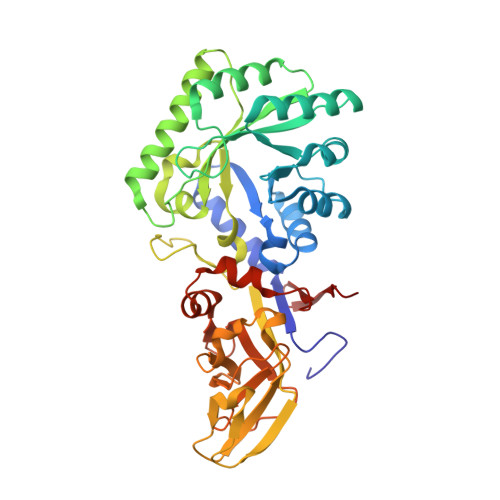Crystal Structure of a Thermostable Alanine Racemase from Thermoanaerobacter tengcongensis MB4 Reveals the Role of Gln360 in Substrate Selection
Sun, X., He, G., Wang, X., Xu, S., Ju, J., Xu, X.(2015) PLoS One 10: e0133516-e0133516
- PubMed: 26218070
- DOI: https://doi.org/10.1371/journal.pone.0133516
- Primary Citation of Related Structures:
4Y2W - PubMed Abstract:
Pyridoxal 5'-phosphate (PLP) dependent alanine racemase catalyzes racemization of L-Ala to D-Ala, a key component of the peptidoglycan network in bacterial cell wall. It has been extensively studied as an important antimicrobial drug target due to its restriction in eukaryotes. However, many marketed alanine racemase inhibitors also act on eukaryotic PLP-dependent enzymes and cause side effects. A thermostable alanine racemase (AlrTt) from Thermoanaerobacter tengcongensis MB4 contains an evolutionarily non-conserved residue Gln360 in inner layer of the substrate entryway, which is supposed to be a key determinant in substrate specificity. Here we determined the crystal structure of AlrTt in complex with L-Ala at 2.7 Å resolution, and investigated the role of Gln360 by saturation mutagenesis and kinetic analysis. Compared to typical bacterial alanine racemase, presence of Gln360 and conformational changes of active site residues disrupted the hydrogen bonding interactions necessary for proper PLP immobilization, and decreased both the substrate affinity and turnover number of AlrTt. However, it could be complemented by introduction of hydrophobic amino acids at Gln360, through steric blocking and interactions with a hydrophobic patch near active site pocket. These observations explained the low racemase activity of AlrTt, revealed the essential role of Gln360 in substrate selection, and its preference for hydrophobic amino acids especially Tyr in bacterial alanine racemization. Our work will contribute new insights into the alanine racemization mechanism for antimicrobial drug development.
- Institute of Ageing Research, School of Medicine, Hangzhou Normal University, Hangzhou, China.
Organizational Affiliation:


















